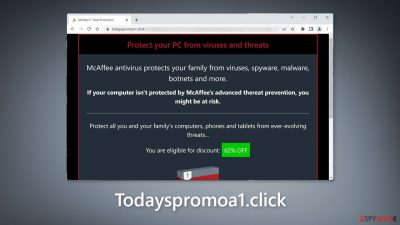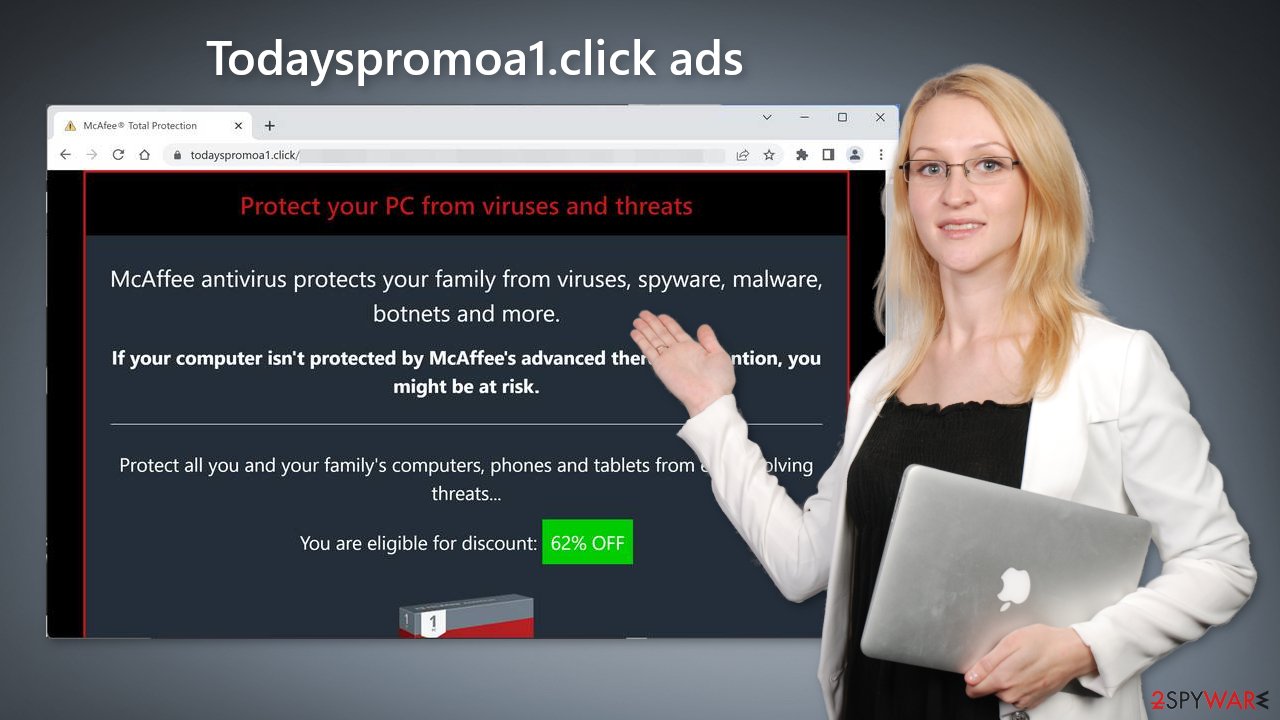Todayspromoa1.click ads (fake) - Free Guide
Todayspromoa1.click ads Removal Guide
What is Todayspromoa1.click ads?
Todayspromoa1.click tries to convince people that their system is in danger to sell antivirus

Todayspromoa1.click is a bogus website used to intimidate users into installing McAfee antivirus. Of course, McAfee has nothing to do with this fraudulent campaign. Crooks are only using their branding to appear trustworthy. The page uses various social engineering[1] methods to convince people that their system might be in danger without an antivirus.
The main goal of this site is to redirect people to the official McAfee website so that crooks could make money through the affiliate program and receive a cut from every subscription purchase. The bogus page may also cause push notification spam. The ads may be placed by rogue advertising networks.
As a result, people can end up on other scam pages that try to lure out personal information or trick them into downloading PUPs (potentially unwanted programs),[2] and even malware. However, the pop-ups can also look like security alerts. This is done in order to make users paranoid and purchase the antivirus.
| NAME | Todayspromoa1.click |
| TYPE | Push notification spam, adware |
| SYMPTOMS | Users may start seeing pop-ups that say their system is in danger; the amount of commercial content on the machine might increase |
| DISTRIBUTION | Shady websites; deceptive ads; freeware installations |
| DANGERS | The website may cause unnecessary installations of antivirus programs or cause pop-ups leading to shady sites |
| ELIMINATION | Check your browser for malicious browser extensions, and scan your machine with anti-malware tools; follow our guide for push notification removal instructions |
| FURTHER STEPS | Use FortectIntego to clear your browsers and get rid of any remaining damage |
Distribution methods
To avoid pages, like Todayspromoa1.click you should only visit websites that you know and trust. Do not click on random links and ads even if they seem to be promoting legitimate products and services. We also advise against using illegal streaming platforms.
They are unregulated, so they are full of deceptive ads and sneaky redirects. They may also display fake “Download” and “Play” buttons that open new tabs. Use legitimate streaming platforms, like Netflix or Hulu. They only require a small monthly subscription fee and people can consume as much content as they want.

Check your browser
Check if your browser is affected by a browser hijacker. Some symptoms may include changed settings (homepage, new tab address, and search engine), increased commercial content, and unknown extensions added to the settings.
Web-based applications can automatically redirect users to scam sites, such as Todayspromoa1.click. You should go to your browser settings and see if any plugins are added. We recommend removing the add-ons one by one to see if you notice any changes.
Disable push notifications
If you want to disable those annoying virus alerts from Todayspromoa1.click, you have to turn off the site permissions that allow it to show you push notifications. You can do that by following our step-by-step guide:
Google Chrome (desktop):
- Open Google Chrome browser and go to Menu > Settings.
- Scroll down and click on Advanced.
- Locate the Privacy and security section and pick Site Settings > Notifications.
![Stop notifications on Chrome PC 1 Stop notifications on Chrome PC 1]()
- Look at the Allow section and look for a suspicious URL.
- Click the three vertical dots next to it and pick Block. This should remove unwanted notifications from Google Chrome.
![Stop notifications on Chrome PC 2 Stop notifications on Chrome PC 2]()
Mozilla Firefox:
- Open Mozilla Firefox and go to Menu > Options.
- Click on Privacy & Security section.
- Under Permissions, you should be able to see Notifications. Click Settings button next to it.
![Stop notifications on Mozilla Firefox 1 Stop notifications on Mozilla Firefox 1]()
- In the Settings – Notification Permissions window, click on the drop-down menu by the URL in question.
- Select Block and then click on Save Changes. This should remove unwanted notifications from Mozilla Firefox.
![Stop notifications on Mozilla Firefox 2 Stop notifications on Mozilla Firefox 2]()
MS Edge:
- Open Microsoft Edge, and click the Settings and more button (three horizontal dots) at the top-right of the window.
- Select Settings and then go to Advanced.
- Under Website permissions, pick Manage permissions and select the URL in question.
- Toggle the switch to the left to turn notifications off on Microsoft Edge.
![Stop notifications on Edge 2 Stop notifications on Edge 2]()
Clear your browsers
After successful removal, we recommend using FortectIntego repair tool to care for your browsers. Almost every website you visit uses cookies to track your browsing activity, like the pages you visit, links you click on, and purchases you make.
If you have pop-ups appearing from questionable sources, it most likely means that you were surfing through web pages you should not have and click on dangerous links. Your browsing data might be exposed or sold to advertising networks and other third parties that use it for malicious purposes.
Use anti-malware tools to scan your machine
Suppose you disabled push notifications and checked the browser for extensions but still, experience unwanted symptoms like unexpected redirects and an increased amount of commercial content. In that case, you should scan your system for adware.[3] We suggest using trusted professional security tools SpyHunter 5Combo Cleaner or Malwarebytes for removal.
It should detect most suspicious apps and remove them successfully. Of course, you can also remove a PUP manually, but it is unknown which particular app could be causing annoying behavior, as crooks disguise them as “handy” tools. Manual uninstallation can also leave some traces of the program behind, which could result in the renewal of the infection.
However, if you still do not want to use security tools and know which program is at fault, use the instructions below to help you uninstall it:
Windows 10/8:
- Enter Control Panel into Windows search box and hit Enter or click on the search result.
- Under Programs, select Uninstall a program.
![Uninstall from Windows 1 Uninstall from Windows 1]()
- From the list, find the entry of the suspicious program.
- Right-click on the application and select Uninstall.
- If User Account Control shows up, click Yes.
- Wait till uninstallation process is complete and click OK.
![Uninstall from Windows 2 Uninstall from Windows 2]()
Windows 7/XP:
- Click on Windows Start > Control Panel located on the right pane (if you are Windows XP user, click on Add/Remove Programs).
- In Control Panel, select Programs > Uninstall a program.
![Uninstall from Windows 7/XP Uninstall from Windows 7/XP]()
- Pick the unwanted application by clicking on it once.
- At the top, click Uninstall/Change.
- In the confirmation prompt, pick Yes.
- Click OK once the removal process is finished.
Mac:
- From the menu bar, select Go > Applications.
- In the Applications folder, look for all related entries.
- Click on the app and drag it to Trash (or right-click and pick Move to Trash)
![Uninstall from Mac 1 Uninstall from Mac 1]()
To fully remove an unwanted app, you need to access Application Support, LaunchAgents, and LaunchDaemons folders and delete relevant files:
- Select Go > Go to Folder.
- Enter /Library/Application Support and click Go or press Enter.
- In the Application Support folder, look for any dubious entries and then delete them.
- Now enter /Library/LaunchAgents and /Library/LaunchDaemons folders the same way and terminate all the related .plist files.
![Uninstall from Mac 2 Uninstall from Mac 2]()
How to prevent from getting adware
Access your website securely from any location
When you work on the domain, site, blog, or different project that requires constant management, content creation, or coding, you may need to connect to the server and content management service more often. The best solution for creating a tighter network could be a dedicated/fixed IP address.
If you make your IP address static and set to your device, you can connect to the CMS from any location and do not create any additional issues for the server or network manager that needs to monitor connections and activities. VPN software providers like Private Internet Access can help you with such settings and offer the option to control the online reputation and manage projects easily from any part of the world.
Recover files after data-affecting malware attacks
While much of the data can be accidentally deleted due to various reasons, malware is one of the main culprits that can cause loss of pictures, documents, videos, and other important files. More serious malware infections lead to significant data loss when your documents, system files, and images get encrypted. In particular, ransomware is is a type of malware that focuses on such functions, so your files become useless without an ability to access them.
Even though there is little to no possibility to recover after file-locking threats, some applications have features for data recovery in the system. In some cases, Data Recovery Pro can also help to recover at least some portion of your data after data-locking virus infection or general cyber infection.
- ^ Cynthia Gonzalez. Top 8 Social Engineering Techniques and How to Prevent Them [2022]. Exabeam. Information Security.
- ^ Wendy Zamora. What is a PUP? – How to avoid potentially unwanted programs. Malwarebytes. Security Tips, Tricks and How-Tos.
- ^ Adware. Wikipedia, the free encyclopedia.










